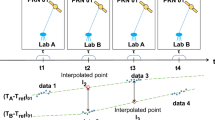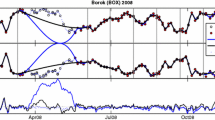Abstract
We processed 30 consecutive days of Global Positioning System (GPS) data using the On-line Positioning Users Service (OPUS) provided by the National Geodetic Survey (NGS) to determine how the accuracy of derived three-dimensional positional coordinates depends on the length of the observing session T, for T ranging from 1 h to 4 h. We selected five Continuously Operating Reference Stations (CORS), distributed widely across the USA, and processed the GPS data for each with corresponding data from three of its nearby CORS. Our results support the current OPUS policy that recommends using a minimum of 2 h of static GPS data. In particular, 2 h of data yielded a root mean square error of 0.8, 2.1, and 3.4 cm in the north, east, and up components of the derived positional coordinates, respectively. Results drastically improve for solutions containing 3 h or more of GPS data.




Similar content being viewed by others
References
Eckl MC, Snay R, Soler T, Cline MW, Mader GL (2001) Accuracy of GPS-derived relative positions as a function of interstation distance and observing-session duration. J Geodes 75(12):633–640
Estey LH, Meertens CM (1999) TEQC: the multi-purpose toolkit for GPS/GLONASS data. GPS Solutions 3(1):42–49
Ghoddousi-Fard R, Dare P (2005) Online GPS processing services: an initial study. GPS Solutions 9(3) (in press)
Kashani I, Wielgosz P, Grejner-Brzezinska DA, Mader GL (2005) A new network-based rapid-static module for the NGS Online Positioning User Service—OPUS-RS. ION 61st Annual Meeting, June 27–29, Cambridge, MA, (Abstract)
Mader GL, Weston ND, Morrison ML, Milbert DG (2003) The On-line Positioning User Service (OPUS). Prof Surv 23(5):26, 28, 30
Snay RA (1999) Using HTDP software to transform spatial coordinates across time and between reference frames. Surv Land Inf Syst 59(1):15–25
Snay RA, Soler T, Eckl M (2002a) GPS precision with carrier phase observations: does distance and/or time matter? Prof Surv 22(10):20, 22, 24
Snay RA, Adams G, Chin M, Frakes S, Soler T, Weston ND (2002b) The synergistic CORS program continues to evolve. In: Proceedings of the ION GPS 2002 (CD-ROM), Institute of Navigation, Alexandria, VA, pp2630–2639
Soler T, Hothem LD (1988) Coordinate systems used in geodesy: basic definitions and concepts. J Surv Eng 114(2):84–97
Soler T, Snay RA (2004) Transforming positions and velocities between the International Terrestrial Reference Frame of 2000 and North American Datum of 1983. J Surv Eng 130(2):49–55
Tétreault P, Kouba J, Héroux P, Legree P (2005) CSRS-PPP: an Internet service for GPS user access to the Canadian Spatial reference Frame. Geomatica 59(1):17–28
Author information
Authors and Affiliations
Corresponding author
Appendix
Appendix










Rights and permissions
About this article
Cite this article
Soler, T., Michalak, P., Weston, N. et al. Accuracy of OPUS solutions for 1- to 4-h observing sessions. GPS Solut 10, 45–55 (2006). https://doi.org/10.1007/s10291-005-0007-3
Received:
Accepted:
Published:
Issue Date:
DOI: https://doi.org/10.1007/s10291-005-0007-3




